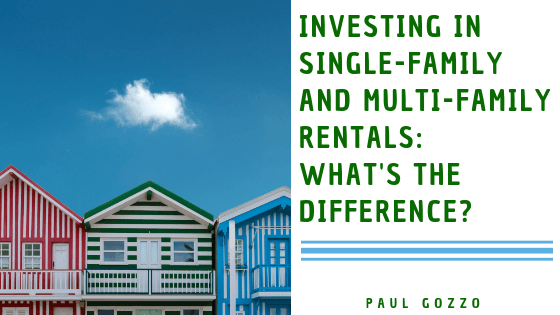Deciphering your strategy for real estate investing can take some time. It is well known that investing in income property can bring both a positive short-term return and long-term gain, but how does one choose the type of property for their first investment? Whether you are new to rental real estate investing or are a seasoned veteran, there are many different types of investments to make, with the most common among smaller investors being in either houses or apartments.
What are single-family and multi-family rentals?
Single-family rentals are typically defined as being a detached dwelling that one family occupies, although the broader understanding is that a SFR unit includes houses, condos, and townhomes. Multifamily real estate properties are buildings with multiple units, such as apartment complexes but also includes smaller buildings such as triplexes and quadplexes . In short, SFR properties usually have one tenant while MFR properties typically house several different tenants in the same structure.
In either case, over the long term, investing in either of these two different types of properties can offer you a good return on your investment. And of course, there are pros and cons to investing in both types of properties. While multi-family units can be advantageous for many reasons, such as having your units all under one roof and location, single-family properties are continuing to increase in popularity. Here are a few general benefits of investing in single-family rentals that are generally not covered in other blogs aimed at education about this asset class when compared to multi-family investing.
Less trouble with tenants. Depending on the grade of the asset, multi-family units tend to face more challenges with tenants, primarily due to many people living in one space. Fielding every complaint can become exhausting from a management perspective, and there isn’t much a landlord can do for the majority of issues with the most common being conflicts that arise in common areas shared by tenants. You’ll also see a higher turnover rate with multi-family units in general than you will with a single-family home. Also, inside the unit and again depending on the grade of the asset, the tenants of a single-family home are more likely to take better care of the unit, treating it more as their very own home.
Affordability and Profitability. Several factors contribute to the financing of properties, but overall, single-family units tend to be less expensive to purchase. And when it comes to maintenance, tenants are usually responsible for paying utilities and overall maintaining the unit. Also, turnover happens less frequently with a single family rental and with less turnover the unit becomes more profitable for you the investor. However, if you choose to be a hands-off owner and pass the responsibility for leasing/managing the unit to a property management company, you will incur the cost associated with that which ultimately eats away at your bottom line.
Diversity within your investment. Another great advantage to investing in single-family real estate rentals is the opportunity to have units in different locations. For example, you could have ten rental units in ten different cities vs. having ten rental units in one building in one city. This offers you the investor a bit more diversity within your portfolio which hopefully equates to a more stabilized investment across your exposure to this one asset class over time. Thankfully, these days there are several technology enabled groups offering busy working professionals the ability to quickly and seamlessly access cash-flowing single-family rental investments throughout the United States. Companies such as Roofstock, Homeunion, and Investability are all great resources to check out.

